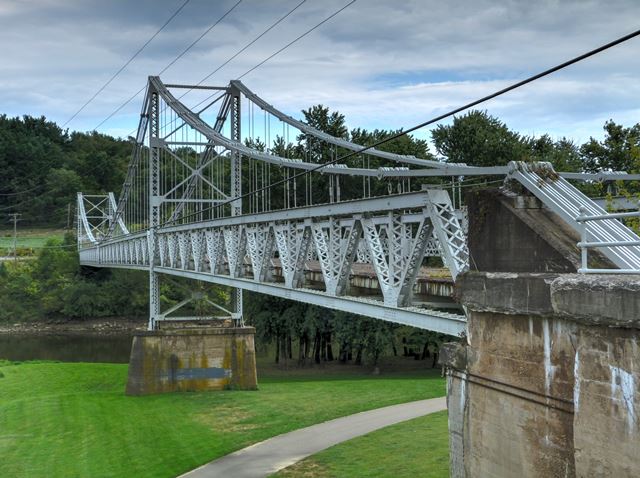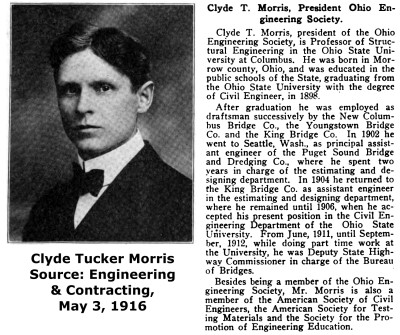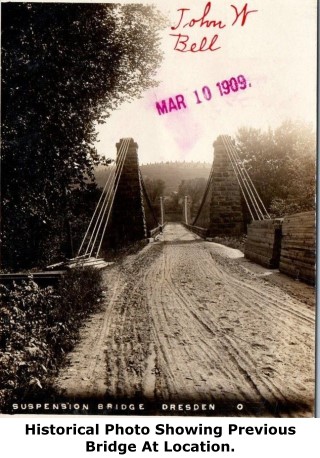We Recommend:
Bach Steel - Experts at historic truss bridge restoration.
BridgeHunter.com Phase 1 is released to the public! - Visit Now
Dresden Suspension Bridge

Primary Photographer(s): Nathan Holth
Bridge Documented: September 11, 2015
Dresden: Muskingum County, Ohio: United States
Metal 24 Panel Pony Truss Stiffening Eyebar Chain Suspension, Fixed and Approach Spans: Metal Rivet-Connected Warren Pony Truss, Fixed
1914 By Builder/Contractor: Bellefontaine Bridge and Iron Company of Bellefontaine, Ohio and Engineer/Design: Clyde Tucker Morris of Columbus, Ohio
Not Available or Not Applicable
443.0 Feet (135 Meters)
705.0 Feet (214.9 Meters)
Not Available
2 Main Span(s) and 1 Approach Span(s)
6005284

View Information About HSR Ratings
Bridge Documentation
This bridge's future is at risk!
Bridge Status: This nationally significant bypassed eyebar suspension bridge is slated for demolition!!!2022 Update: From Nathan Holth, HistoricBridges.org Author: Got a "surprise" email January 24th, 2022 about a meeting where I have learned the ODOT district that owns this bridge is seeking demolition of this bridge, which is one of the most unique and significant bridges in Ohio. The demolition apparently doesn't need federal funding or Army Corps permits so Section 106 doesn't apply. They say the actual project is 3-4 years out. I am deeply disappointed that demolition would even be considered for a bridge of this rarity. In my opinion the biggest cost or challenge to full restoration is deck replacement, and this could be delayed indefinitely if the bridge was more securely blocked off, then the deck could be removed and the bridge left as a monument. The steel deterioration shown in the meeting appears to be confined to traditional trouble areas, such as below expansion joints and bearings, in splash zone and mositure areas below deck. Widespread steel repairs do not appear needed to the main superstructure.
Below is a video about the bridge where leading Ohio bridge historian David Simmons speaks to the significance of this bridge:
View Historic American Engineering Record (HAER) Documentation For This Bridge
View An Engineering Textbook By Clyde T. Morris
View An Article By David Simmons
View National Register Nomination Form For This Historic Bridge
This bridge is one of a very small number of eyebar suspension bridges in the United States. This type of bridge was far more common in England in the 19th Century, and was not commonly built in the United States, with wire cable being more common.
The bridge may be the oldest eyebar suspension bridge in the United States that still functions as a suspension bridge, as the only known older examples have had load-bearing beams added that made the suspension system decorative only.
The bridge has a few unique design features beyond the use of eyebars. The west end of the bridge is a traditional combination anchorage/abutment, however at the east end the eyebars soar over the OH-666 roadway and enter into smaller anchorages (which do not double as abutments) that are set atop a small rocky cliff, making the eastern anchorage is higher than the western anchorage as a result. Another aspect of assymttry with this bridge is that only the center and western spans are suspended. East of the eastern tower, the eyebars have no suspenders and the shorter span east of the east tower is a simple pony truss span of design nearly identical to the stiffening truss. Finally, the stiffening truss is unusual in that it has a top chord which turns into end posts at the center panel, and eliminates a top chord at that panel. This gives the bridge an unusual "notched" appearance at the center.
The consulting engineer for this bridge was a well-known as an OSU Professor and author of textbooks. He also was one of multiple engineers associated with the infammous Silver Bridge over the Ohio River, which was also an eyebar suspension bridge. Unlike the Silver Bridge, the Dresden Bridge has many more eyebars in the bundle, despite being a far shorter span. This only serves to illustrate one of the several downfalls of the Silver Bridge. The Silver Bridge was an oddity, the Dresden Suspension Bridge represents the more familiar and reliable design with a thick bundle of numerous eyebars forming the main catenary, reflective of European design in the 19th Century. It is perhaps because of this traditional (not revolutionary) design, that although rare among bridges in America today, the Dresden Suspension Bridge recieved little attention in engineering periodicals of the period. Regardless, it should be counted among the most notable of Ohio's rich collection of historic bridges today. It was bypassed in 1988 by a profoundly ugly modern bridge that is a stark contrast to the grace and beauty of the historic bridge. The historic bridge was fortunately left standing and not demolished, but unfortunately is officially closed to even pedestrian traffic with no trasspassing signs posted. This bridge should be a high priority for repair and reopening for pedestrian use. Very few if any repairs would be needed to make it worthy for pedestrian use.
The previous bridge at this location was also a suspension bridge, but appears to have been a wire cable suspension with stone towers.
Information and Findings From Ohio's Historic Bridge InventorySetting/Context The bridge, which has been bypassed, is closed to traffic and pedestrians. Chain-link fences and "no trespassing" signs have been placed at both ends. A new bridge has been built to the upstream (north) side (ca. 2000). At the west end of the bridge is a riverside park and boat launch. Beyond the northwest quadrant is the Dresden High School. At the east end of the bridge is a T-shaped intersection. The bridge crosses over the Muskingum River and a flood plain on the west side of the river. There is a high bluff on the east side of the river. Physical Description The 3 span, 705'-long suspension bridge has a 443'-long center span. It is an eye-bar chain suspension bridge with built-up steel towers and Warren stiffening truss. The eye-bar chains are composed of multiple eyebars linked by pins. The western anchorage is located within the concrete wingwalls. The eastern concrete anchorage is located on the east side of SR 666 in a farmer's field, a configuration made necessary by the topography and roadway plan. The bridge has built-up steel towers with transverse crossbracing. The suspender rods with turnbuckles are connected to the upper chords of the stiffening trusses by pins. The stiffening trusses are riveted Warren pony trusses composed of standard built-up sections. The trusses have rolled floorbeams with knee braces to the roadway faces of the verticals. The floorbeams support steel stringers and a steel deck pan. The bridge is supported on concrete abutments and piers. Integrity Recently painted. No obvious alterations other than deck replacement (June 2009). Summary of Significance The Dresden Suspension Bridge is NR Listed (1976). The bridge was bypassed ca. 2000. The bridge is 1 of 2 eyebar chain suspension bridges in the inventory (the other is the 1895 Mill Creek Park bridge in Youngstown). Justification One of two documented eye bar suspension bridges in the state, the design is rare and the significance is high. Bridge Considered Historic By Survey: Yes |
![]()
Photo Galleries and Videos: Dresden Suspension Bridge
Bridge Photo-Documentation
Original / Full Size PhotosA collection of overview and detail photos. This gallery offers photos in the highest available resolution and file size in a touch-friendly popup viewer.
Alternatively, Browse Without Using Viewer
![]()
Bridge Photo-Documentation
Mobile Optimized PhotosA collection of overview and detail photos. This gallery features data-friendly, fast-loading photos in a touch-friendly popup viewer.
Alternatively, Browse Without Using Viewer
![]()
Maps and Links: Dresden Suspension Bridge
Coordinates (Latitude, Longitude):
Search For Additional Bridge Listings:
Bridgehunter.com: View listed bridges within 0.5 miles (0.8 kilometers) of this bridge.
Bridgehunter.com: View listed bridges within 10 miles (16 kilometers) of this bridge.
Additional Maps:
Google Streetview (If Available)
GeoHack (Additional Links and Coordinates)
Apple Maps (Via DuckDuckGo Search)
Apple Maps (Apple devices only)
Android: Open Location In Your Map or GPS App
Flickr Gallery (Find Nearby Photos)
Wikimedia Commons (Find Nearby Photos)
Directions Via Sygic For Android
Directions Via Sygic For iOS and Android Dolphin Browser
USGS National Map (United States Only)
Historical USGS Topo Maps (United States Only)
Historic Aerials (United States Only)
CalTopo Maps (United States Only)



